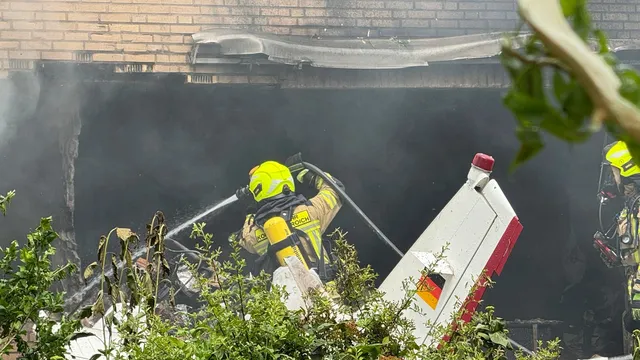
Two people die after small plane crashes into house in Germany
2025-05-31 13:30- A small plane crashed into the terrace of a residential building in Korschenbroich, Germany.
- Local police confirmed that two people were killed, with one believed to be the pilot.
- Investigations are ongoing to determine the cause of the crash and the specific identities of the victims.
Express your sentiment!
Insights
On Saturday, a tragic incident occurred in Korschenbroich, Germany, when a small plane crashed into the terrace of a residential building. Local police reported that two individuals lost their lives as a result of this incident. The crash took place in western Germany, close to the city of Mönchengladbach and not far from the Dutch border. It was later clarified that the pilot had been attempting to land at the nearby Mönchengladbach airport when mechanical problems arose mid-air. Witnesses described hearing a loud noise before the aircraft hit the building, causing significant damage. Upon impact, a fire erupted from the wreckage, sending thick black smoke billowing into the sky. Emergency services rapidly responded to the scene, deploying firefighters, police, and rescue teams to manage the situation. Reports indicated that the property suffered both fire damage and structural issues as a consequence of the collision. The police investigation revealed that one of the deceased individuals was likely the pilot of the aircraft. However, it was unclear if the second victim was aboard the plane or on the ground at the time of the crash. This uncertainty heightened the distress surrounding the incident as friends and family awaited more information about the victims' identities. Authorities are currently conducting a thorough investigation into the incident, focusing on the mechanical issues that led to the crash. Initial reports suggest that this was a tragic accident, but the full circumstances surrounding it are yet to be established. As crews continue to clear the site and assess the damage, the community is left shaken by the unexpected loss of life and the destruction caused by the small plane crash.
Contexts
The emergency response plan for plane crashes is a crucial document that outlines the procedures and protocols to ensure an effective and swift response in the event of an aviation accident. Such a plan should involve a coordinated effort among various agencies and stakeholders, including airport authorities, first responders, airline representatives, and local and federal government entities. A well-defined emergency response plan typically features key components such as communication strategies, resource allocation, and personnel training. Clear lines of communication must exist to facilitate the immediate sharing of critical information among emergency responders and management teams to reduce response times and efficiently mobilize services. Training is an essential aspect of an emergency response plan for plane crashes. First responders should undergo regular drills and simulations that mimic potential crash scenarios. This training prepares them to handle the unique challenges of a plane crash, including the possibility of fire, hazardous materials, and mass casualties. Additionally, specialized teams should be trained in the use of equipment specific to aviation incidents, such as foam firefighting agents, crash scene management tools, and medical response techniques directed at trauma victims. Support for victims' families also plays a crucial role in the overall response, and the plan should include structural support systems for these individuals in the wake of an accident. Effective coordination among various agencies is imperative. The NIMS (National Incident Management System) framework can be utilized to unify the response efforts across federal, state, and local agencies. This systematic approach helps ensure that roles and responsibilities are clearly defined and that resources are utilized efficiently. Establishing an incident command system allows for the monitoring of the situation and the prioritization of tasks in the immediate aftermath of an incident. Additionally, relationships with local hospitals should be established beforehand, specifically addressing triage capabilities and bed availability for surge situations arising from a plane crash. Finally, post-incident analysis is critical for continual improvement of the emergency response plan. After an incident, agencies should conduct debriefings to evaluate the effectiveness of the response and identify areas for improvement. Feedback from all participating agencies is integral to understanding the response dynamics and enhancing preparedness for future incidents. This iterative process promotes a culture of safety and preparedness, ensuring that lessons learned directly contribute to refining protocols and re-evaluating resource inventory, ultimately enhancing overall emergency preparedness for aviation-related accidents.